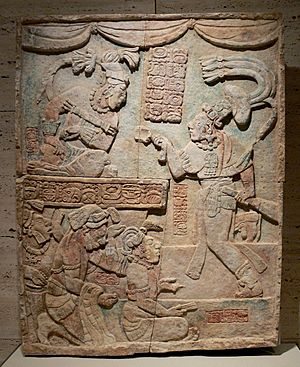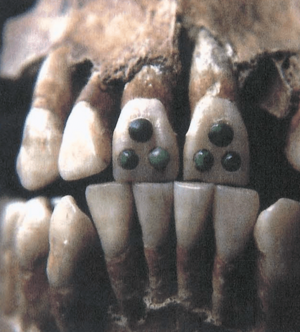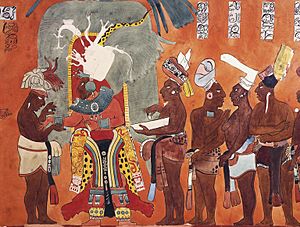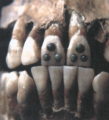Maya society facts for kids
The Maya were an amazing civilization that lived in Mexico and Central America a long time ago, before Europeans arrived. They were very important in Central America until about the 6th century.
The Maya were super smart! They made big discoveries in astronomy (studying stars), mathematics, agriculture (farming), art, and writing. They were truly excellent in these areas. Sadly, many of their great cities were left empty by the year 900 AD.
The Maya lived in a region called Mesoamerica, mostly in the Yucatán Peninsula, northern Guatemala, and southern Mexico. Their civilization was at its strongest during the Classic Period, from about 250 AD to 900 AD. After that, they started to decline.
The Maya also liked to change their bodies in different ways, like shaping their heads, filing their teeth, and getting tattoos or piercings. These changes often showed their social status, protected them from bad spirits, or marked important life events.
Warfare was common for the Maya. They fought to get resources, control nearby lands, and capture people for work.
Contents
Maya Kingdoms and Rulers
During the Classic Period, Maya society was organized into small kingdoms. Each kingdom was led by a ruler called an ajaw, or later, a kʼuhul ajaw. These rulers inherited their position, meaning it was passed down in their family.
These kingdoms were usually like city-states. They had a main city and a few smaller towns nearby that they controlled. Some kingdoms were much larger, like those ruled by Tikal and Caracol. These powerful kingdoms controlled bigger areas and even other smaller kingdoms.
Each kingdom had its own name, which wasn't always the same as its capital city. For example, the city of Naranjo was the capital of the Saal kingdom. Even with lots of wars and changes in power, most kingdoms stayed around until the whole system collapsed in the 9th century.
Experts who study the Maya now believe that the royal family and especially the king were at the very center of Maya society. They think that all the big Maya buildings and spaces, like palaces, temples, and plazas, were used for the royal family's activities. These places helped show who had power and how society was organized. They also helped spread the Maya's artistic and moral values.
Spanish explorers described Maya cities as groups of homes built around the temples and palaces of the rulers and nobles. While some Maya cities were known for certain goods, they weren't as big or busy as the Aztec capital, Tenochtitlan. Some people think Maya cities were more like huge royal households. They were places where important nobles could meet the ruler, where high culture was created, and where beautiful items were enjoyed. These cities were seen as the heart of social, moral, and cosmic order. If a royal court fell, like at Piedras Negras or Copán, the city often died out too.
Maya Social Classes
Maya society had a very strict system of social classes. It was hard to move up in society. Your job was often decided by your father's job. So, if your dad was a farmer, you would likely be a farmer too.
The highest class included rulers, nobles, and priests. The middle class had businessmen, merchants, and soldiers. The lowest class was made up of farmers and people who were forced into service.
Scribes and Writers
Scribes, who were people who could read and write, were very important in Maya courts. They even had their own special gods! Many scribes came from noble families and probably had different ranks among themselves. Some scribes worked for the royal family, while others worked in temples and might have been considered priests. Maya art often shows rulers with things that suggest they were scribes or could write, like pen bundles in their headdresses. Many rulers have also been found with writing tools, such as ink pots made of shell or clay.
Body Modifications
For the ancient Maya, changing their bodies was a way to show who they were as individuals and as a part of their culture. These changes could be a symbol or even a political statement. Beauty was also a way to show off social and moral values. So, body modifications had reasons related to beauty, religion, and society.
Dental Modifications
Changing teeth might have been a way to show which family, kingdom, ruler, or region someone belonged to. How teeth were modified depended on a person's social status and where they lived.
The Maya had two main ways of changing their teeth: filing and inlay. Filing meant changing the tooth's shape to make notches, grooves, or points. This started very early in Maya history, around 1400-1000 BCE. They used stone tools and water to do this. Inlay meant drilling holes to put different materials inside the teeth. This was popular around 900-600 BCE. Later, both methods were used, but filing was more common.
Teeth were probably changed for rituals or to look good. Younger children usually didn't have modified teeth. Once their adult teeth came in, teenage warriors sometimes had their teeth filed to sharp points. This made them look fierce and was a sign of their status. Maya women also filed their teeth or had holes drilled into them. Precious stones like jade, pyrite, hematite, or turquoise could be placed in these holes. High-status women often had their teeth filed in different patterns. The meaning of the inlay changed depending on the material. For example, jade symbolized pure breath or the ability to speak elegantly.
Most of what we know about Maya dental modification comes from old European writings from the 16th century. However, these accounts can be biased. More reliable information comes from studying Maya art, like pottery and paintings, and from the actual teeth found in Maya burial sites. Scientists have found signs of dental disease on these ancient teeth, which shows that these modifications were done on living people.
Changing teeth was important because different tooth styles showed certain things about Maya religion and social status. It showed ideas about wealth, power, and how people spoke. For example, front teeth were sometimes filed into a "T" shape to represent "wind." Wind was very important to the Maya, as it symbolized "life force" and honored the maize god. The famous Maya King Pakal had his teeth filed into a "T" shape. This changed his face to make him look like he was squinting, which was a direct reflection of the maize god. Since these modifications were painful, they were likely a way to show that someone had become an adult and could handle pain.
Skin Modifications
Body paint, tattoos, and scarification (making scars on purpose) were all used by the Maya. They showed important life events and different social classes. We can't study skin modifications from human remains. So, what we know about Maya tattoos, scarification, and body paint comes from art like pottery and murals, tools and containers for paint, and old historical writings.
Body Paint
Body paint designs were very specific to different places. The colors and patterns changed depending on the region. Two common colors were red, made from cinnabar or vermilion with hematite and iron ore. Another very important color was a blue or green pigment. It was made with indigo and a mineral called Palygorskite. This blue/green color was highly valued because it was linked to jade and to sacrifices made to the gods.
Evidence for body painting comes mostly from murals. One mural found in Bonampak shows an important man being painted red from his neck down by a servant. A woman's face is also painted red. Another mural at Calakmul shows merchants and common people wearing face paint of different colors and designs. This suggests that paint might have been used to show class and gender.
Tattoos and Scarification
Even though tattoos and scarification are physically different, the Maya might not have seen them as separate practices. Tattoos and scarification were used to mark important events in Maya life. One old account says: "A thief from the highest class is punished by having his face tattooed on both sides from the beard to the forehead. … the young men do not tattoo except to a slight degree until marriage."
Some experts believe that certain tattoos and scars were linked to the elite. This is because "killing" and "rebirth" of the skin through cutting created a connection with death and the rebirth of gods. It is also thought that some types of tattooing and scarification showed bravery and courage.
Piercings
All Maya people pierced their ears, lips, nose, or cheeks. However, the type of jewelry they wore showed their social status. Children would get piercings at a young age. Their ear flares and spools would get bigger as they grew, stretching their ears. Most of the evidence for Maya piercings comes from jewelry found in tombs, like labrets (lip plugs) and ear spools. Old historical writings also tell us about the many high-quality piercings the Maya wore.
Maya Warfare
The Maya fought wars throughout their history. They fought to settle arguments with rivals, get important resources, and control trade routes. Large battles also happened to decide and protect territories, as well as to gain economic power. The Maya protected their cities with defenses like wooden fences, gates, and earth walls. Some cities even had an inner wall, so enemies would get trapped.
During the later Classic Period, there was a lot more fighting between Maya cities. Armies grew larger, and sometimes even hired fighters from other places. The destruction of many cities from these wars contributed to the decline of the Maya civilization.
Military Organization
The ruler of a Maya city was the top war leader. Some rulers only planned military actions, while others actually fought in battles. There was a main group of warriors who served all year as guards. But most large Maya cities and religious centers had militias. These were men who were paid to fight during a battle, and then they would go back to their farms or crafts.
Militia units were led by nacoms, who were war chiefs whose position was passed down in their family. They used smart strategies in warfare. Some nacoms were only planners, and the troops were led into battle by batabs, or officers. In a big war, even common people who didn't have weapons would fight using hunting tools or by throwing rocks. In some mountain regions, women sometimes fought in battles, according to old Maya stories.
War Tactics
The jungle landscape of Mesoamerica made it hard for large armies to travel. Warriors who knew the land well could cleverly retreat into the familiar wilderness. Other war tactics included surrounding cities to cut them off and forming alliances with smaller enemies to defeat bigger ones. There is evidence that canoes were used to attack cities located on lakes and rivers. In the late Classic Period, destructive war methods, like burning cities, became more common.
Warfare Rituals
Warfare was a special ritual process for the Maya, and they believed the gods approved of it. Military leaders often had religious authority too. Before going into battle, armies would call upon the gods with dances and music from drums, whistles, conch shell horns, and singing. The drumming and war cries signaled the start of the battle. Armies also carried religious statues into battle to inspire their warriors. They fought fiercely because they believed that dying on the battlefield would bring them eternal happiness. Being captured by the enemy was considered worse than any death. When an enemy was defeated, the winning army would take their religious symbols and sometimes humiliate the defeated leader by keeping them captive for a long time.
Weapons and Uniforms
The Maya used many different weapons. These included atlatls (spear-throwers), blowguns, clubs with sharp obsidian spikes, spears, axes, lances, and knives with flint or obsidian blades. Bows and arrows were also used, but not as much.
While there were few helmets, Maya warriors used decorated shields made from woven mats, wood, and animal skins for protection. Maya war leaders dressed to inspire their warriors and scare their enemies. They usually wore padded cotton armor, a cloak with religious symbols, and fancy wooden and cloth headdresses. These headdresses often represented the animal spirit or "way" of the warrior. Metal was not used in battle because it was very rare.
Images for kids






